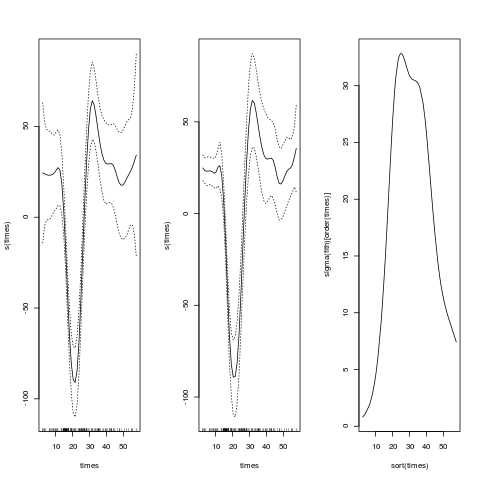Supported by Dr. Osamu Ogasawara and  providing providing  . . |
|
Last data update: 2014.03.03 |
Estimate varying residual varianceDescriptionEstimates a varying residual variance on basis of an asp object. UsageaspHetero(object, xx, nknots=5, knots=NULL, basis="os", degree=c(3,2), tol=1e-8, niter=100, niter.var=250) Arguments
ValueAn object of class asp with varying variances, with additional element Author(s)Manuel Wiesenfarth m.wiesenfarth at dkfz de ReferencesWiesenfarth, M., Krivobokova, T., Klasen, S., Sperlich, S. (2012). Examples
#dontrun{
attach(mcycle)
y=accel
kn1 <- default.knots(times,20)
# fit model with constant residual variance
fit= asp2(accel~f(times,basis="os",degree=3,knots=kn1,adap=FALSE),
niter = 20, niter.var = 200)
# fit model with varying residual variance
fith=aspHetero(fit,times,tol=1e-8)
op <- par(mfrow = c(1,3))
plot(fit);plot(fith)
#sigma() returns the fitted varying residual variance
plot(sort(times),sigma(fith)[order(times)],type="l")
par(op)
#}
Results
R version 3.3.1 (2016-06-21) -- "Bug in Your Hair"
Copyright (C) 2016 The R Foundation for Statistical Computing
Platform: x86_64-pc-linux-gnu (64-bit)
R is free software and comes with ABSOLUTELY NO WARRANTY.
You are welcome to redistribute it under certain conditions.
Type 'license()' or 'licence()' for distribution details.
R is a collaborative project with many contributors.
Type 'contributors()' for more information and
'citation()' on how to cite R or R packages in publications.
Type 'demo()' for some demos, 'help()' for on-line help, or
'help.start()' for an HTML browser interface to help.
Type 'q()' to quit R.
> library(AdaptFitOS)
Loading required package: nlme
Loading required package: MASS
Loading required package: splines
AdaptFitOS 0.62 loaded. Type 'help("AdaptFitOS-package")' for an overview.
Please cite as:
Wiesenfarth, M., Krivobokova, T., Klasen, S., & Sperlich, S. (2012).
Direct simultaneous inference in additive models and its application to model undernutrition.
Journal of the American Statistical Association, 107(500), 1286-1296.
Attaching package: 'AdaptFitOS'
The following object is masked from 'package:stats':
sigma
> png(filename="/home/ddbj/snapshot/RGM3/R_CC/result/AdaptFitOS/aspHetero.Rd_%03d_medium.png", width=480, height=480)
> ### Name: aspHetero
> ### Title: Estimate varying residual variance
> ### Aliases: aspHetero
> ### Keywords: smooth
>
> ### ** Examples
>
> #dontrun{
> attach(mcycle)
>
> y=accel
> kn1 <- default.knots(times,20)
> # fit model with constant residual variance
> fit= asp2(accel~f(times,basis="os",degree=3,knots=kn1,adap=FALSE),
+ niter = 20, niter.var = 200)
>
>
> # fit model with varying residual variance
> fith=aspHetero(fit,times,tol=1e-8)
> op <- par(mfrow = c(1,3))
> plot(fit);plot(fith)
Critical value for f(times): 3.315361
Critical value for f(times): 3.371649
> #sigma() returns the fitted varying residual variance
> plot(sort(times),sigma(fith)[order(times)],type="l")
> par(op)
> #}
>
>
>
>
>
> dev.off()
null device
1
>
|
